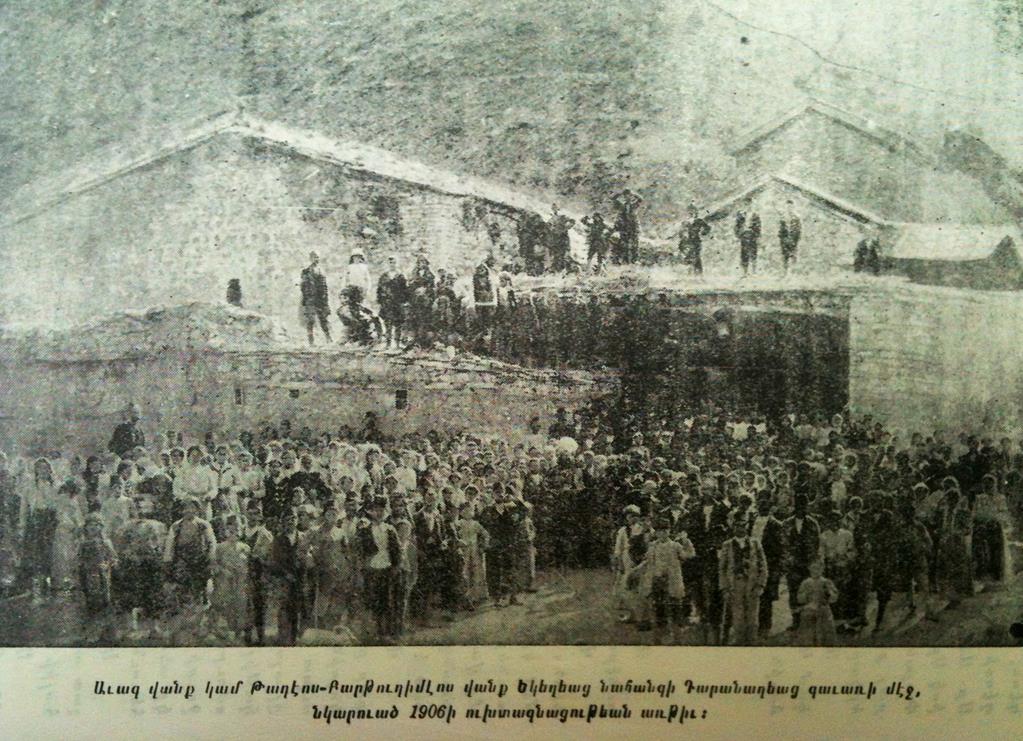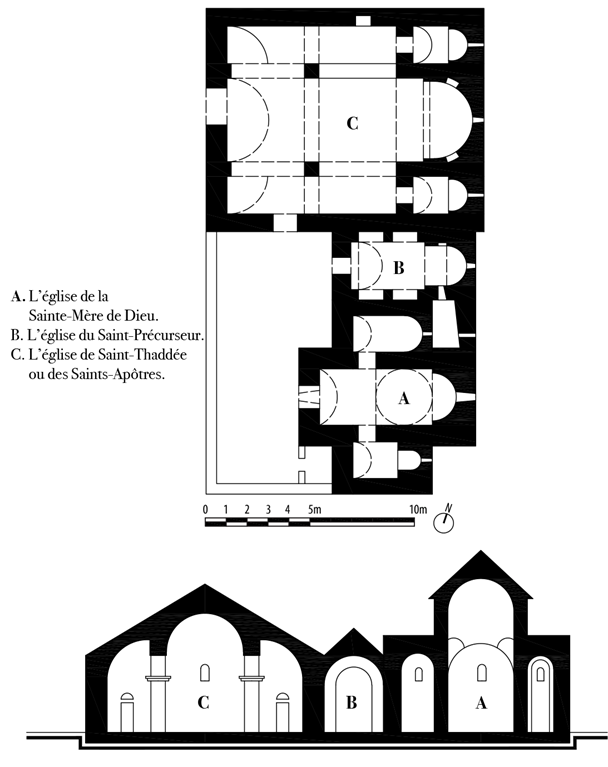Known as Avak Vank‘ (the Great Abbey), this monastery, dedicated to the Apostle Saint Thaddeus, or more precisely to the Apostles Thaddeus and Bartholomew, stands above the village of Garni [Gökkaya] at an altitude of some 2000 meters, at 39° 40’ N and 39° 15 E. It is lodged in a small valley on the southern slopes of the Kohanam mountains [Köhnem] and Mount Sebuh [Kara Dağ], between Erznga [Erzincan] and Gamakh/Kemakh [Kemah], which trace a semicircle on the right bank of the western Euphrates River. Encompassed in the canton of Taranaghi, Mount Sebuh is associated in Armenian history with the life of Saint Gregory the Illuminator (Surp Krikor Lussavorich), who at the start of the 4th century, during the reign of Tiridate IV (Drtad), brought about the conversion of the kingdom of Armenia to Christianity. Saint Gregory withdrew to the Taranaghi to spend the rest of his days as a hermit near the caves of Manayark on Mount Sebuh. There are many convents and hermitages on this holy mountain, the presence of which echoes the withdrawal and death of the Saint in this place. This is the case of the convent of the Illuminator, just below the summit (n° 45), or of the Tomb of the Nine Saints of T‘ortan, where tradition locates his final burial place (n° 47). The same is true of Avak Vank‘, the most famed of these establishments for its monastic activity, which, in view of legitimization, conjoins in one sanctuary the preaching of the Apostles and that of Saint Gregory the Illuminator.

General view of Saint Thaddeus and the Holy Mother of God during the pilgrimage, 1906 (Surménian, 1947, p.87).
In the 12th century, Avak Vank‘, or the Great Abbey, was home to a large community of monks and had a productive scriptorium. Until the end of the 15th century, it would number among the foremost scriptoria and monastic universities in Armenia, where, under the authority of such great priors as John (Hovhannes), Sergius (Sarkis) and Asdwadzadur at the turn of the 13th century, Moses of Erznga (Movses Erzengatsi) and Cyriacus (Guiragos) in the 14th century, George of Erznga (Kevork Erzengatsi) and John of Hamshen (Hovhannes Hamchentsi) in the 15th century, a number of talented copyists and miniaturists would distinguish themselves: Vartan of Garin (Vartan Garnetsi), who in 1202 completed the famous so-called “Moush [Muş] homilary”, one of the largest manuscripts in the world (see n° 54); or renowned scholars like the great Doctor John, homonym and contemporary of John of Hamshen. At the time the latter were teaching, in the third quarter of the 15th century, the community seems to have numbered some sixty religious and laymen at least, of whom thirty were novices. The monastery was an episcopal seat at that time. The triple dedication of the Great Abbey – to the Holy Mother of God (Surp Asdwadzadzin), to the Holy Precursor John the Baptist (Surp Garabed) and to the Holy Apostles (gen. Arak‘elots) – is attested from the earliest historical texts and corresponds to the existence of a bloc of three churches conserved down to the present, with the existence of a fourth attested between the 13th and the 15th centuries. The first could be an ancient foundation going back to the 7th-10th century. The monastery was renovated or enlarged at the time of Prior Moses of Erznga, early in the 13th century. Other improvements or changes were made around 1464 by the monk Asdwadzadur Dchermatsi.
The Mount Sebuh school fell into decline in the 16th century with the Ottoman conquest. The Doctor and monk Malachai of Terjan [Tercan] (Maghak‘ia Terjantsi), having managed to obtain a reduction of the tax on Avak Vank‘ and the see of Gamakh/Kemakh, enriched it with new constructions, among which a second narthex at the entrance to the churches. If Avak Vank‘ was unable to recover its former glory in the following centuries, it nevertheless remained a revered pilgrimage destination. Beginning in the 17th century, the Prokhoroniants family provided Avak Vank‘ and the other monasteries on Mount Sebuh with an unbroken line of administrators and superiors – often secular priests. The monastery was attacked in 1895. Before the Great War, the superior of the Mount Sebuh convents was Father Vartan Prokhoroniants, whose son was assassinated in 1903 and buried on the site.
The Great Abbey includes:

Plan and section (Thierry, 2005, 109).
• (A) The church of the Holy Mother of God, a singular edifice in the form of a free-standing cross with pitched roofs, composed of a nave with a barrel vault over the western part and surmounted in front of the apse by a drum, octagonal in form on the inside and rectangular on the outside, and flanked by two side chapels to the north and south.
• (C) The larger church of Saint Thaddeus or the Holy Apostles, a basilica with three naves and two bays with arches set on imposts, engaged columns on the east and west sides, and two square central pillars.
• (B) The church of the Holy Precursor with a barrel vault, set between the above two churches.
• A first narthex situated at the entrance to the church of the Holy Apostles.
• A second narthex built further to the south in the 16th century, in front of the other two churches.
• A big courtyard wall against which the outbuildings were constructed – lodgings, storeroom, refectories, library.
Two cross-stones, dated 1466 and 1469, can be seen in the largest church, that of the Apostles, whose main door was embellished with two carved panels. Avak Vank‘ held the Teght‘ap‘, or “Antidote”, a precious stone engraved with the portraits of a Roman imperial couple, which had been used as the base of a reliquary of the Illuminator. The monastery also owned lands, woods and orchards.

Church of Saint Thaddeus, interior, 2008 (Private Coll.).
Avak Vank‘ was confiscated and left empty after the Great War. The courtyard wall and outbuildings have all but disappeared, as have the two narthexes. Alone the three churches form a compact bloc, perfectly visible but badly damaged. A large portion of the roofs has disappeared, the drum of the Holy Mother of God is partially destroyed, and the church of the Holy Apostles is riddled with cracks in several places.
Oskian, 1951, 3-25. Thierry, 2005, 109-112. Surménian, 1947, 86-88. Matévossian, 1969, 137-162.
SaveSave